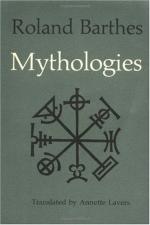
|
| Name: _________________________ | Period: ___________________ |
This test consists of 5 multiple choice questions, 5 short answer questions, and 10 short essay questions.
Multiple Choice Questions
1. Which of the following is not part of the whole system of values for a myth in "The Form and the Concept"?
(a) An audiology.
(b) A morality.
(c) A geography.
(d) A history.
2. "The relation which reunites the concept of the myth to its meaning is essentially a relation of ____." How is this quote from "The Form and the Concept" finished?
(a) Probability.
(b) Implication.
(c) Deformation.
(d) Exclamation.
3. In "The New Citroen" what is the modern equivalent of great Gothic cathedrals?
(a) Cars.
(b) Fashion.
(c) Subways.
(d) Skyscrapers.
4. The workers mentioned in "The Great Family of Men" of the Goutte d'Or are from where?
(a) Northern Africa.
(b) South Africa.
(c) Paris.
(d) Lebanon.
5. What flowers does the author use to signify his passion in "Myth is a Semiological System"?
(a) Roses.
(b) Lilies.
(c) Orchids.
(d) Daisies.
Short Answer Questions
1. Mythology is a part of ideology in what way according to "Myth is a Semiological System"?
2. What is the second point the author makes of the science of semiology in "Myth as a Semiological System"?
3. What is one of the functions of myth in "Myth is Depoliticized Speech"?
4. Which type of photograph "suggests the tyranny of an ideal" in "Photography and Electoral Appeal"?
5. According to "The Form and the Concept" what is the second term of the system in Freud?
Short Essay Questions
1. Does the author admit there are revolts against the bourgeois ideology in "The Bourgeoisie as a Joint-Stock Company"? What is it called?
2. What is history's role concerning myth as a type of speech, according to "Myth is a Type of Speech"?
3. What is "the inoculation"?
4. Why does Marguerite only send the audience "to sleep" in "The Lady of the Camellias"?
5. What does the author suggest is characteristic of myth in "Myth as a Stolen Language"?
6. What are the three ways in which one can understand the myth in "Reading and Deciphering Myth"?
7. How is the woman in "Striptease" an object in disguise? What is the point of this?
8. In myth, what is the tri-dimensional pattern described by the author in "Myth as a Semiological System?" What is the title the author gives to the system that existed before the myth?
9. In "Myth is a Type of Speech" what does the author say that myth is? What does he say that a form of speech is?
10. How is plastic a "miraculous substance," according to the author in "Plastic"?
|
This section contains 968 words (approx. 4 pages at 300 words per page) |

|




